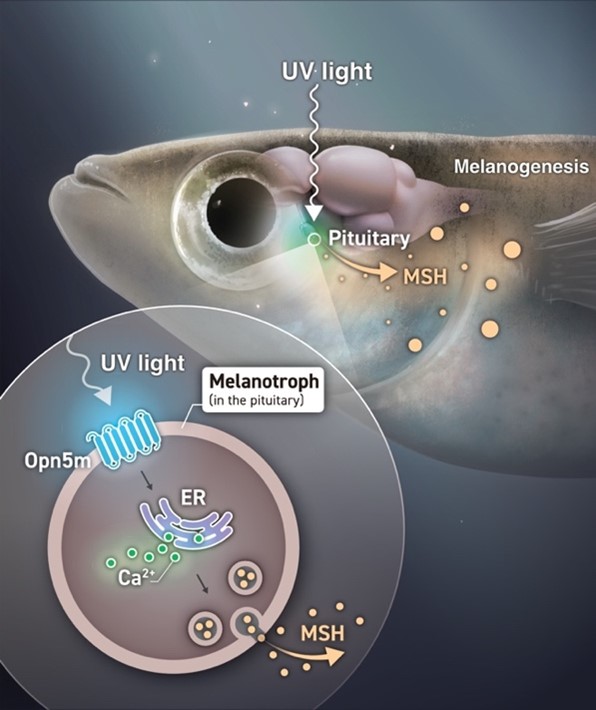DATE2025.01.07 #Press Releases
Ultraviolet rays protection using hormones
--Medaka sense ultraviolet light in their pituitary glands and darken their bodies to protect them from UV rays--
Summary
A research group led by Associate Professor Shinji Kanda of Atmosphere and Ocean Research Institute, The University of Tokyo, and Assistant Professor Keita Sato of Okayama University Graduate School of Science, in collaboration with Kyoto University, and Kobe Pharmaceutical University, has shown that hormone-producing cells in the pituitary gland of medaka fish, when exposed to UV radiation from outside the body, release melanocyte-stimulating hormone (MSH) and enhance protection from UV light by stimulating melanogenesis on the body surface (Figure).
Although it has been known that photoreceptor genes are expressed in tissues other than the eye, such as the brain, this study is the first to show that hormone-producing cells in the pituitary gland, which is located even deeper than the brain, possess functional photoreceptors and have a mechanism to percept light and release hormones. The significance of each non-visual photoreceptor's sensing of specific wavelengths of light has not been clarified in many previous studies, but this research result has various novelties in that it also explains the meaning of wavelengths: UV light (UV-A) is received in the pituitary gland to enhance UV protection of the body surface. The results of this research suggest that organisms with relatively transparent heads hide unknown light-utilizing pathways, and are expected to lead to many discoveries in the future.

Figure: UV protection mechanism by pituitary photoreception found in medaka
A novel phenomenon in which the pituitary gland of the medaka fish (Oryzias latipes) directly receives light and releases hormones: sunlight, including UV light (UV-A), penetrates the cranium of the medaka fish and reaches the pituitary gland (Pituitary). The non-visual photoreceptor Opn5m on the MSH-producing cells (melanotrophs) receives the light and increases in intracellular Ca2+, causing the release of MSH. The released MSH stimulates melanogenesis on the body surface, resulting in darkening of the body color. This mechanism may be useful in protecting the body from UV light.
Related link: Atmosphere and Ocean Research Institute, The University of Tokyo
Published Journals
-
Journal name ScienceTitle of paper


